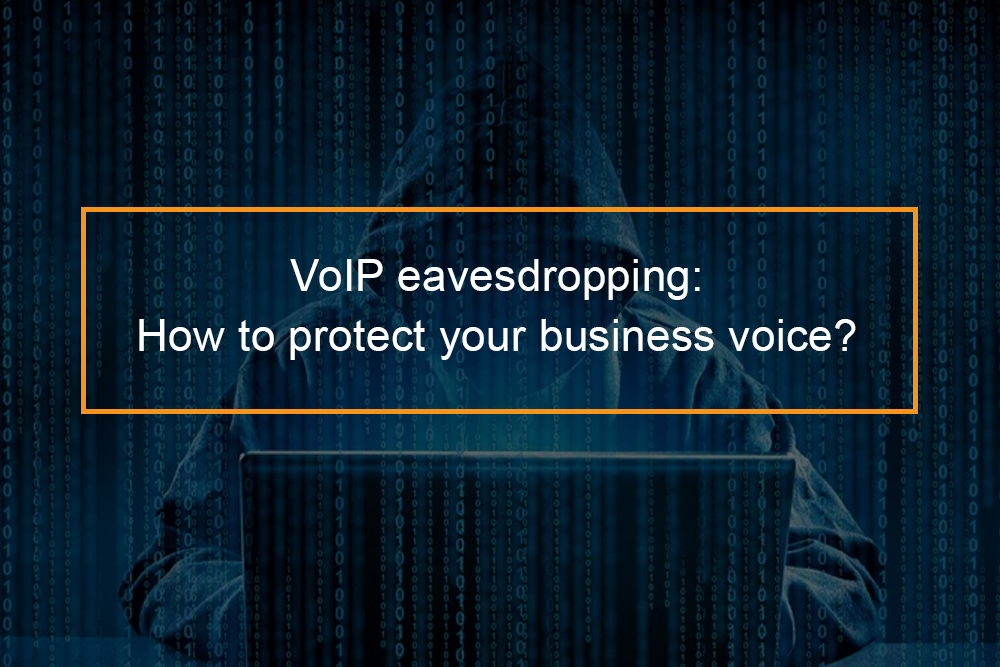
Updating your SBCs is one of the technologies that you can use to protect VoIP against eavesdropping. Update the Session border controllers the same way you update antivirus applications. Your SBC requires the same kind of management regimen you should already have in place for your other security tools.
Each company considering a Voice over Internet Protocol (VoIP) telephone system deployment should know about routing voice calls over a data network that exposes calls to eavesdropping. Whereas any telephone call indeed carries a specific degree of eavesdropping risk, it is also true that Voice over Internet Protocol calls has a higher chance of risk. In this article, we look at various technologies of VoIP eavesdropping.
How to combat VoIP eavesdropping?
Protect VoIP against eavesdropping
There is a rich record of Voice over IP eavesdropping, inclusive of attacks like Peskyspy, Vomit, and SIPtap. Below are five tips to combat Voice over IP eavesdropping:
-
Use no Voice over IP (VoIP) phone with default setups
Too many deployments end up in those doing the rollout in a rush to have things finished. You should not implement VoIP phones with a default setup since bad actors can look for vendor documentation as well as anybody.
Based on your VoIP solution, you should have alternatives to change the handset via policy. Otherwise, you will require to come up with a manual procedure to change telephone defaults when you roll handsets out to your employees.
-
Tune into your handset vendors
It is good to monitor advisories from your hardware vendors often. You have to make monitoring like reports part of someone’s job. Otherwise, you risk being caught by surprise or even worse realize that someone has been eavesdropping on one corporate VoIP phones.
-
Use encryption for your voice VoIP calls
Most cloud Voice over IP providers provides call encryption guidelines for their customers. Some providers even offer encryption as a premium service. In case you work in a regulated market such as health care or financial industry, encryption of your VoIP voice calls could be integral to staying a complaint. Work with your VoIP provider to recognize the best encryption options for your communication infrastructure.
-
Have your employees create sophisticated passwords
To protect your business, system and employees have all your VoIP users use complicated passwords. Having a complex password is one of the easiest methods you can use to assist protect your system from hackers. Fortunately, most hackers are not that advanced, so they regularly look for the systems that have no passwords in place or the ones that use a weak password.
-
Use a hosted VoIP
You can strengthen your security and add additional layers of protection; use hosted VoIP provider. A hosted VoIP provider can assist you in protecting your system and fending off new security threats because they are staffed with IT specialists in keeping your VoIP phone system safe and maintained. The best part is hosted VoIP services are provided to you as part of your Voice over IP and will not add additional costs to your company.
-
Adopt strict security policies with users
Let your users know your phones’ in-built security features. You can also delete sensitive voicemail messages after users have listened to them. Not storing voicemails is the simplest way to protect them.
Report anomalies immediately. You may also know a telephone that has been hacked until a staff reports an old occurrence, like a saved voicemail message that has been removed or forwarded to an unprecedented telephone number.
Protect your IP phones and voice system by partnering with Cisco partners to help you protect your company’s voice and business assets- and raise your happiness by simplifying your safety job and offering excellent support.
-
Create a hardened VoIP network
Another alternative technology for combatting VoIP eavesdropping is creating a hardened Voice over IP network including:
- IP PBX (private branch exchange) using minimal services so that the hardware can support only the PBX solution.
- Firewalls with access control lists configure to include call control data, lightweight directory access protocol lookup, and signaling and management protocols; and reinforced endpoint security with authentication at the endpoint level.
The National Insitute of Standards and Technology has studied VoIP network security and provide its recommendations for federal government agencies looking to harden their internal VoIP systems and networks to protect sensitive and classified data.
-
Utilize basic security controls to network switches
One of the essential things that network administrators can do to decrease VoIP risks like eavesdropping is to adopt basic security controls to network switches. Whereas endpoint safety is essential, the network switch is the point where traffic is aggregated. Widespread eavesdropping attacks are possible via the malicious use of a switch’s span port, which can mirror all traffic traveling the switch, as opposed to the voice traffic from a single endpoint.
Below are some switch management best practices that can assist in protecting this vital element of network infrastructure.
- It is essential to make sure the switch is physically secured within a locked closet and has the right access controls. In case an attacker can gain physical access to a switch, all the bets are off.
- Companies should use a separate network for the management of switches and other vital infrastructure tools. It should be impossible or challenging for an attacker who gains access to one general-purpose network to attempt to get access to the management port of a network device.
- Companies must update switch firmware as often as possible so that they can patch vulnerabilities corrected by the service provider. Naturally, there is much more to secure switch management.
VoIP eavesdropping: how does it happen?
First of all, it is significant to know that it is possible to eavesdrop on a Voice over IP telephone call. It is also feasible to eavesdrop on a telephone call placed using the traditional public switched Telephone Network. The contrast is in the techniques and tools required to conduct the eavesdropping.
On a traditional telephone network, someone looking to eavesdrop on a call typically must have physical access to either telephone cable or the telephone, at least at the initiation of the attack. This kind of attack is common in the movies. Whether it is bad or good guys carrying the eavesdropping, somebody gains access to either a telephone handset or the phone network interface box, sometimes located outside a residential or office, puts a wiretap listening appliance on the box, and then monitors calls on an ongoing basis.
Prospective VoIP eavesdropping follows the same general process but utilizes different tools. The first thing he or she needs is access to the medium carrying the VoIP voice calls. This can be attained by comprising a VoIP phone, a workstation running a softphone appliance, or an element of the VoIP network infrastructure, like a network switch or cable. Then, the attacker must use application tools to capture the traffic on the network. Apart from wiretapping devices in a traditional eavesdropping attack, network sniffing tools, get all the data packets traveling across the network, and either analyze them live or note them to a file for offline analysis.
Lastly, the attacker requires to be able to make sense of the captured information. This needs a translator that can change the data packets into a voice conversation. Besides, there are free applications online like VoIPong, VOMIT that facilitate this task.
In which situation would a detective control be warranted?
The situation in which detective control can be warranted
Detective control is an accounting terminology that refers to a kind of internal control that is intended to find issues within a company’s procedures. Detective control may be used for many reasons like fraud prevention, legal compliance, and quality control.
The detective control is warranted when the company requires to check on the prohibited activity. It is done when the company or its network is having an intrusion and threat as well as identification of antivirus and detection of threats on the company. These procedures are carried out to recognize threats and correct them by implementing backup plans. In case the threats are too dangerous, then business continuity plans are adopted.









